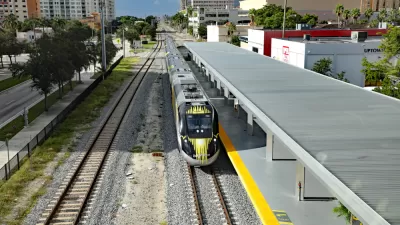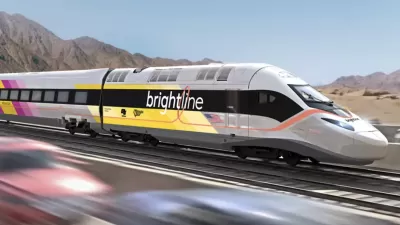On Tuesday, the California High-Speed Rail Authority announced that the cost of the project has tripled to nearly $99 billion, and federal funds for it don't exist yet--prompting some legislators' support to fizzle.
Mike Rosenberg and Steven Harmon elaborate on other figures, either previously overestimated (ridership) and underestimated (fares)--and what other financing schemes the state may look to next:
"The rail authority hopes the federal government will launch a new tax-credit bond program and create grants that would initially provide $30 billion for the project, matched with $11 billion in existing state and federal funds, to build a stretch of track long enough to start service. Those tracks would stretch from the Central Valley to either San Jose or San Fernando Valley, with train service beginning in 2022.
From that point on, the state hopes to make a profit, which officials project will spark $11 billion in private investments, an additional $35 billion in federal grants and $10 billion from various sources such as local governments and private companies."
FULL STORY: More grim news on $99 billion high-speed rail plan, as showdown looms

Alabama: Trump Terminates Settlements for Black Communities Harmed By Raw Sewage
Trump deemed the landmark civil rights agreement “illegal DEI and environmental justice policy.”

Study: Maui’s Plan to Convert Vacation Rentals to Long-Term Housing Could Cause Nearly $1 Billion Economic Loss
The plan would reduce visitor accommodation by 25% resulting in 1,900 jobs lost.

Why Should We Subsidize Public Transportation?
Many public transit agencies face financial stress due to rising costs, declining fare revenue, and declining subsidies. Transit advocates must provide a strong business case for increasing public transit funding.

Paris Bike Boom Leads to Steep Drop in Air Pollution
The French city’s air quality has improved dramatically in the past 20 years, coinciding with a growth in cycling.

Why Housing Costs More to Build in California Than in Texas
Hard costs like labor and materials combined with ‘soft’ costs such as permitting make building in the San Francisco Bay Area almost three times as costly as in Texas cities.

San Diego County Sees a Rise in Urban Coyotes
San Diego County experiences a rise in urban coyotes, as sightings become prevalent throughout its urban neighbourhoods and surrounding areas.
Urban Design for Planners 1: Software Tools
This six-course series explores essential urban design concepts using open source software and equips planners with the tools they need to participate fully in the urban design process.
Planning for Universal Design
Learn the tools for implementing Universal Design in planning regulations.
Smith Gee Studio
Alamo Area Metropolitan Planning Organization
City of Santa Clarita
Institute for Housing and Urban Development Studies (IHS)
City of Grandview
Harvard GSD Executive Education
Toledo-Lucas County Plan Commissions
Salt Lake City
NYU Wagner Graduate School of Public Service




























